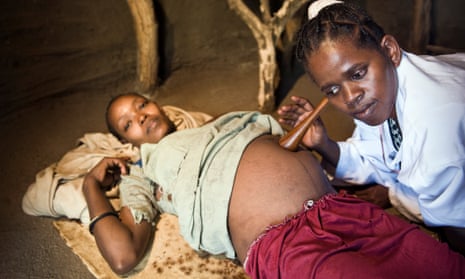At a dispensary in Nyaluoyo village in western Kenya, there is just one midwife on duty. There are three women in labour, about 40 children waiting to be vaccinated, and another 15 people with other ailments.
It is 3pm and the lone midwife has yet to take lunch. She does not earn enough to buy school books for her own child, and she cannot meet other basic monthly needs. She has participated in health worker strikes in the past to push for higher salaries, but to no avail.
Africa has taken great strides in developing a favourable policy environment for reproductive and maternal health. But this positive environment has not translated into better health for African women, because it has not been supported by the funding required for implementation.
In 2001, 189 African heads of states and governments met in Abuja, Nigeria, where they committed to spending at least 15% of their annual budgets on improving the health sector (although it is important to note that even this level of commitment is not adequate to meet needs across the continent).
Ten years on, only six countries had kept this promise. Fourteen years later and the vision seems to have been lost altogether, with 11 countries actually reducing their relative contributions during the period.
The consequences are tragic, with maternal health epitomising the impact that underfunding can have on a health system. Too many Africans, including mothers, are dying of preventable diseases. The main causes include weak health systems characterised by poor infrastructure, inadequate supplies of drugs and equipment, a critical shortage of health workers, and weak management capacity.
A woman living in sub-Saharan Africa has a one in 16 chance of dying in pregnancy or childbirth, compared with a one in 4,000 risk in a developing country. The major causes of maternal deaths are preventable ones, including haemorrhage, infection, hypertensive diseases and unsafe abortion.
For reasons beyond their control, more than half of African women deliver at home without the services of a skilled birth attendant. It is estimated that sub-Saharan Africa needs 551,000 additional midwives by the end of 2015 to bridge its deficit, a tall order that cannot be met with the meagre resources currently committed to health systems.
In fact, at the current rate of increase in midwife numbers, it will take an estimated 29 years to reach the World Health Organisation’s recommended numbers in Africa.
As 2015 progresses, it is becoming increasingly obvious that countries in Africa will not meet millennium development goal five, which aimed to reduce maternal mortality by 75% between 1990 and 2015. In sub-Saharan Africa, for example, the figure has been reduced by 41%; in northern Africa, by 66%.
Amref Health Africa works to bridge this gap by training cadres of community health workers, nurses and midwives – strengthening the provision of care at facility level, linking communities to formal health services and supporting the realignment of these services to community needs. We’re successful in our field, but in itself this – and the work of numerous NGOs – simply isn’t enough. It is imperative that governments devote more resources to their health systems.
Almost all African governments, for example, are yet to meet the target of committing 15% of their national budgets to health. Donor funding is estimated to account for more than a quarter of total healthcare funding in about 35% of African countries, while in 5% of countries more than half of all healthcare funding comes from external sources.
While this support is important, it is not sustainable. The lack of domestic resources devoted to healthcare is undermining the positive policy environment for maternal and reproductive health.
The Continental Policy Framework on Sexual and Reproductive Health and Rights and the Maputo Plan of Action are key instruments guiding Africa’s efforts to achieve maternal health goals. The Campaign on Accelerated Reduction of Maternal, Newborn, and Child Mortality in Africa, an initiative of the African Union, serves as a critical advocacy platform for improvement of maternal, newborn and child health, and has been launched in more than 40 of the 54 AU member states. The campaign has motivated national ownership of significant maternal, newborn, and child health initiatives.
Without adequate funding, however, these laudable initiatives lack teeth.
Saving a mother is the most definite pathway to giving children the future they deserve. To eradicate poverty and underdevelopment, we must all commit to breaking the vicious cycle by making pregnancy and childbirth safer.
- Dr Joachim Osur is head of reproductive and child health at Amref Health Africa, based in Kenya
